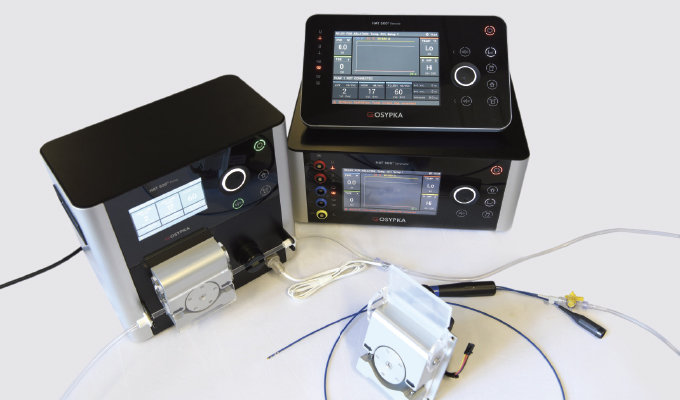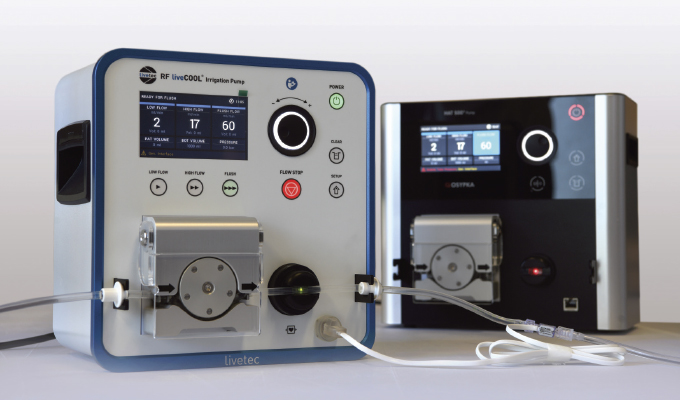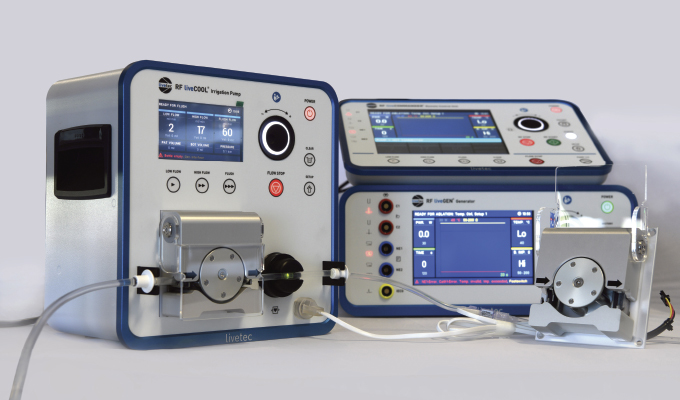Medical device manufacturers Livetec and OSYPKA are using a 400RXMD peristaltic pump from Watson-Marlow Fluid Technology Solutions (WMFTS) as part of a cardiac ablation system for its high reliability and ease of operation.
The OEM pump is specifically designed for surgical ablation systems with simple integration (which reduces time and cost associated with extended installation), low noise levels and precise control. The 400RXMD is available with DriveSure which integrates motor, mounting and supports Industrial Ethernet as well as analogue protocols.
RELIABLE AND EASY OPERATION
Livetec’s products include temporary cardiac pacemakers, wireless long-term electrocardiogram (ECG) Holter systems, low-level laser devices or a long-term ECG for heart attack and stroke prevention. The Lörrach, Germany-based company’s medical technology products are sold either directly under its own brand name Livetec® or as a white label under the brands of many established manufacturers. Sometimes it is both, as in the case of RF LiveGEN Generator for high-frequency catheter ablation, which is available on the market under both its own brand and as HAT500 RF ablation system from OSYPKA, a pioneer of RF (radiofrequency) ablation and manufacturer of reliable, high quality medical devices.
“This system, a Class IIb medical device, uses our development experience and the extensive application experience of OSYPKA,” explains Michael Schirmeier, managing director of Livetec.
Radiofrequency catheter ablation can be used to efficiently treat cardiac arrhythmias (irregular heartbeat) directly on the heart. During treatment, radiofrequency energy (500 kHz) is transmitted to the treatment site via a catheter inserted through a vein under X-ray control.

FLUSHING AND COOLING THE CATHETER
The ablation system developed by Livetec and OSYPKA consists of the RF generator, a remote-control unit and an irrigation pump for flushing and cooling the catheter during cooled ablation procedures. Together, they form a comprehensive system for almost all ablation applications on the human heart. In cooled ablation applications, an irrigation pump conveys a saline solution to the electrode at the tip of the catheter for better treatment results. The solution is dispensed through tiny irrigation holes in the catheter tip.
RF LiveCOOL (1-60 mL/min), from Livetec, is a low-noise irrigation pump for use with high-frequency ablation generators to perform cooled radiofrequency ablation therapies on the human heart. RF LiveCOOL works with the RF LiveGEN generator to control the flush flow depending on the RF energy output.
The irrigation pump, which is usually mounted directly on the infusion stand, transports the saline solution from an infusion bag or bottle to the tip of the catheter. It has a clear user interface with a high-resolution color touch display for easy operation without lengthy training times. As it is absolutely crucial that no air enters the bloodstream during treatment, the irrigation pump offers permanent detection of air bubbles from 2 μl with automatic stop, as well as vital permanent monitoring and display of pressure and flow rate. The 400RXMD used in the irrigation pump sucks the saline solution from the infusion bag and conveys it into the catheter via a thin tube.
“Ablation treatments usually take several hours and the pump must provide saline solution continuously during this time, so absolute reliability of all components is of course essential,” Schirmeier says. During treatment, any malfunction would lead to a discontinuation of treatment.
“The pump must be easy to operate. Above all, however, it has to overcome the high back pressure caused by very narrow catheter channels with a very small diameter (lumen) in the micrometer range. Despite the high back pressure, it must be possible to control the flow rate absolutely precisely at any time, so that the exact volume flow required for the respective treatment step is achieved. The peristaltic pump is one of the central components in the system and must provide absolute reliability over several years and many treatments.”

MINIMIZING RISK
The 400RXMD OEM pump offers flow rates of up to 500 mL/min and a pressure of up to 9 bar, so it can handle the high back pressure present in ablation applications.
Schirmeier adds, “During operation, the pump has to deliver three different flows. The most challenging is certainly the flush flow at the start of the treatment, which ensures that there is no more air in the tubes. Depending on the catheter, the pump must perform up to 80 mL/min while the catheter is connected to the tubing-set. This results in high back pressures of up to 5 bar through the narrow catheter channels or irrigation holes. But the pump is easily able to overcome the back pressure without exceeding the pressure limits that could damage the catheter.
“None of the other pumps we tested could deliver similar delivery rates and they were not as good in terms of mechanical compatibility as the Watson-Marlow 400RXMD. The pump and drive can be installed easily in the overall system of the irrigation pump.”
The 400RXMD is designed to meet the needs of catheter, cannula or needle cooling applications and minimizes the risk of human error. Hose clamps in the pump head ensure the tubing is automatically positioned correctly each time the pump head cover is closed.
Depending on the application requirements, the 400RXMD can be customized to the application requirements. For example, the 400RXMD used as part of the irrigation pump system has five rollers. This reduces pulsation, reducing noise and the risk of electrically induced interference on the intracardiac ECG (“ECG noise”) that is transmitted through the catheters, according to Livetec.
Schirmeier adds, “The ablation systems from Livetec and OSYPKA have been on the market for more than five years, with a total of several hundred devices in use. Until now, there have been no complaints due to wear due to a pump. All are still working smoothly.”
FOR MORE INFORMATION
Watson-Marlow Fluid Technology Solutions (WMFTS) is a world leader in manufacturing niche peristaltic pumps and associated fluid path technologies for the life sciences and process industries. WMFTS is a wholly owned subsidiary of Spirax-Sarco Engineering plc, with operations in forty-three countries. For more information, visit www.wmfts.com.
MODERN PUMPING TODAY, March 2024
Did you enjoy this article?
Subscribe to the FREE Digital Edition of Modern Pumping Today Magazine!


